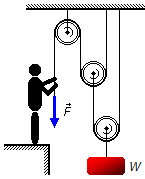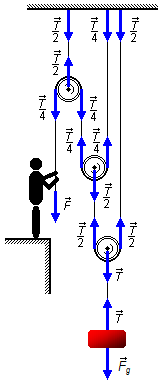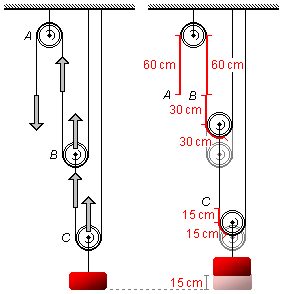Solved Problem on Static Equilibrium
advertisement
A body with weight W is suspended by a system of pulleys and ropes. Assuming these elements are
lightweight and the pulleys and ropes have no friction. Determine:
a) The force that man must apply to the rope to keep the body in static equilibrium;
b) If the rope is pulled down 60 cm, how much does the body be lifted?
a) The force that man must apply to the rope to keep the body in static equilibrium;
b) If the rope is pulled down 60 cm, how much does the body be lifted?

Problem data:
- Weight of the body: W.
a) To keep the body in static equilibrium, the force exerted by man must be equal to the gravitational
force of the body from the static equilibrium
\[
\begin{gather}
\vec F={\vec F}_g \tag{I}
\end{gather}
\]
In the body acts the gravitational force
\( {\vec F}_g \)
and tension force
\( \vec{T} \)
in the rope
\[
\begin{gather}
{\vec F}_g=\vec{T} \tag{II}
\end{gather}
\]
The tension force is transmitted through the rope to the pulley where the body is attached. For the
system to be in equilibrium, the tension force must be equally divided between both sides of the pulley.
On each side, we have a tension equal to
\( \frac{\vec T}{2} \)
acting on the rope. The lower pulley is attached to another pulley where acts this tension
\( \frac{\vec T}{2} \).
For the equilibrium of the system the tension must be divided between the two sides of the middle
pulley. On each side, we will have a tension equal to
\( \frac{\vec T}{4} \).
This tension is transmitted by the rope to the pulley fixed to the ceiling, this pulley only transmits
the tension from one side to another, where the man holds the rope. Using equation (II), we find
that the gravitational force that will act on the rope at this point is
\( \frac{{\vec F}_g}{4} \),
and a system of two movable pulleys divides the load's weight by 4. Thus, from equation (I) the force
the man exerts will be

\[
\begin{gather}
\bbox[#FFCCCC,10px]
{F=\frac{F_g}{4}}
\end{gather}
\]
b) When the rope is pulled down by 60 cm, a point A on the rope (Figure 2) moves down by 60 cm.
Since this pulley is fixed to the ceiling, the rope on the other side of the pulley rises 60 cm. Since
the middle pulley is free, a point B on the rope must rise the same 60 cm. Of this value, 30 cm is
the displacement of the point, and the other 30 cm results from the upward movement of the pulley itself,
which is being pulled up. As the middle pulley rises 30 cm, a point C on the rope of the lower
pulley must rise by 30 cm as well. Similarly, since the lower pulley is free, 15 cm will be the
displacement of the point, and the other 15 cm represents the rise of the pulley itself. Since the body
is attached to this pulley, it will rise by 15 cm along with the lower pulley.
The body will be lifted by 15 cm. 15 cm.
The body will be lifted by 15 cm. 15 cm.

advertisement

Fisicaexe - Physics Solved Problems by Elcio Brandani Mondadori is licensed under a Creative Commons Attribution-NonCommercial-ShareAlike 4.0 International License .